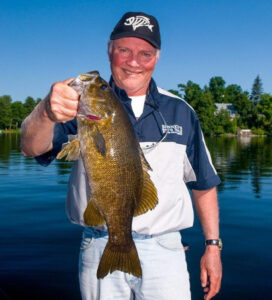Zebra mussels are found in many smallmouth waterways within the U.S. and Canada. Anglers fishing lakes with established zebra mussel populations typically encounter clear water, mussel-colonized structures and big smallmouth preferring deep habitat. It seems as if fishing for smallmouths and zebra mussels go hand in hand.
While zebra mussels have had profound ecological and economic impacts, Joe Balog of Harrison Township., Mich., notes anglers will catch plenty of smallmouth using the right tactics when fishing around these shelled creatures. Balog has decades of experience in this regard. He’s an accomplished tournament angler and his home waters of Lake St. Clair and Lake Erie first contained zebra mussels in the late 1980s.
“Yes, they’re sharp and can cut your line, but I’ve fished lots of places with much sharper mussels,” Balog said. “The barnacles at the Chesapeake Bay or the James River are much sharper, so zebra mussels aren’t something to be fearful of, from a fishing standpoint.”
Depending on where you’re fishing, you may encounter quagga mussels (see sidebar), another invasive species. In the Great Lakes, quaggas are replacing and outnumbering zebra mussels. Quaggas look similar to zebra mussels and have a similar impact to waterways and fishing tactics. For practical purposes in this story I refer to zebra mussels, but the fishing info below also applies to quagga-occupied waters.
If you’ve yet to deal with zebra mussels, or are looking for smallmouth tactics for fishing around these pesky mollusks, you should consider the following 6 things:
- Two impacts on fishing tactics
- Fish deeper
- Scan and see
- Fast food
- Clear-water tactics
- Prevent the spread
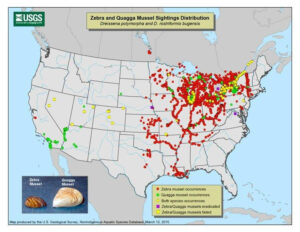
TWO IMPACTS ON FISHING TACTICS
Zebra mussels disrupt a lake’s ecosystem. For one, these small sharp-shelled mollusks colonize anything they can.
The U.S. Geological Survey’s Zebra Mussel Fact Sheet states: “Zebra mussels attach to any stable substrate in the water column or bottom: rock, rooted plants, artificial surfaces (cement, steel, wood, plastic, rope, etc.), crayfish, native clams, and each other, forming dense colonies.”
Lure and line contact with a zebra mussel colony is like fishing across a cheese grader. It may cut the line or, at the very least, deliver a few scrapes and nicks. Fluorocarbon’s the most durable option.
Zebra mussels’ filter-feeding also impacts a lake. While phytoplankton (algae) is their food, they also siphon in other microscopic items, removing them from the water and depriving small native animals of this food source. Over time, this can increase water clarity and disrupt the food web, which can change smallmouth preferred locations and feeding behavior.
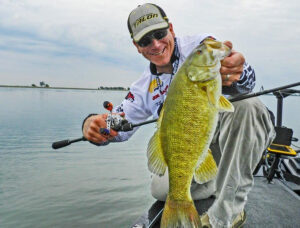
FISH DEEPER
Balog’s seen fishing patterns change on the Great Lakes as well as inland systems in Michigan, Ohio and New York as a result of zebra mussels. Smallmouth shifting to deeper structure is a common trend.
“As zebra mussels get into a lake and improve clarity, light penetrates much deeper, and vegetation grows deeper,” Balog said. “Fishermen need to understand that bass will not be stacked up on a nice shoreline when the water is real clear, with lots of deep vegetated flats. Anglers need to look for the larger structures of rocks and grass and larger schools of bass in the main lake basins.”
Over 400 miles away from Balog’s home waters, lies a 1,500-acre lake on the edge of the Canadian Shield in Ontario. Wally Robins is a cottage resident on this lake and fishes smallmouth several days a week from June opener to early fall. A diligent notetaker for decades, he noticed smallmouth behavior changes 5 years after mussels arrived in 2002.
Like Balog, Robins catches a lot of big smallmouth around deep structure. Before zebra mussels, he’d catch quality smallmouth from various depths on points, reefs and other structures. Now, shallow and mid-depth areas are less productive.
“I’ve found the lake produces more and better fish on the deepest edge of an underwater point than it did 15 to 20 years ago,” Robins said. “I target the basin edge of structure much more, especially if there’s a significant drop, like going from 20 feet into 40 or deeper.”
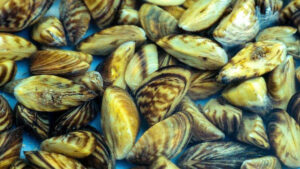
SCAN AND SEE
Tracking down smallmouth on deep-water structure takes time. Quality sonar and an underwater cameras are important tools. Balog begins using Humminbird’s Side Imaging to cover water and pinpoint productive areas.
“The whole key is to determine which of the major structures the majority of the bass are using, and electronics do this,” Balog said. “Graphs, especially with Side Imaging, are the first key.”
After locating concentrations of fish, Balog lowers an Aqua-Vu Micro 5 underwater camera. The unit’s a valuable tool in clear water. The camera lets him confirm he’s located smallmouth on structure, and not freshwater drum (sheepshead), which graph similar to bronzebacks. In clear water, cameras also reveal habitat features, bass size, forage and other valuable fishing clues.
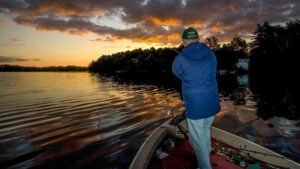
FAST FOOD
Shad are a main forage base for smallmouth in Robins’ lake. Since zebra mussels arrived, though, bass feeding frenzies have shortened.
“One of my all-time favorite early morning flats used to hold gangs of marauding small jaws from a half hour before sunrise until 8:15 to 8:30 a.m., a span of more than three hours,” Robins said. “Today, that feeding window is open for about an hour, sometimes less. Light conditions play a role in this and, in uber-clear water systems, feeding binges often occur in low or no light conditions. To my mind, we can blame zebras for tweaking the entire food chain and subsequently, smallie behavior.”
Robins keeps several G. Loomis rods rigged with various baits to capitalize on these short smallmouth feeding windows. Jerkbaits, spinnerbaits and bladed swim jigs haul-in hyperactive smallies. Then, soft-plastic stickbaits, tubes and drop shots are used to catch loitering bass looking for crippled shad.
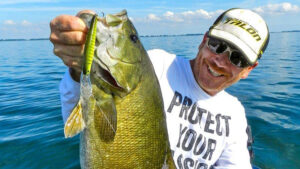
CLEAR WATER TACTICS
Balog and Robins share similar tactics for catching smallmouth in clear, zebra-infested lakes. Here are 7 of their most effective tips:
- Use fluorocarbon – Fluorocarbon’s the most durable line choice for fishing zebra mussels. Fluoro’s near-invisible quality underwater is equally good for clear lakes. Balog uses 6-pound Sufix for drop-shotting, Sufix 832 braid to an 8-pound fluoro lead for tubes, and straight 12-pound fluoro for big jigs and most hard-bait applications.
- Be natural – “Probably the biggest tip I can give traveling anglers is to leave all of their gaudy stuff at home,” Balog said. “Around here, it’s the more natural things that prevail, watermelon plastics, ghost minnow jerkbaits, gold spinnerbaits.”
- Cast jerkbaits – “Clear, northern waters are just dynamite for jerkbait fishing,” Balog said. “It covers vast amounts of water, and is a good choice under the widest range of conditions.” Top picks are the Lucky Craft Pointer 100 and Staysee, and Rapala X-Rap Deep.
- Try different sizes – “Bait size is ten times more important than color,” Robins said. “I advise that anglers cycle through 4, 5 and 6-inch jerkbaits to get dialed in on the body profile and size of the forage of the day.”
- Match the hatch – Smallmouth can be picky in clear water. Match lure profile accordingly. Thin and slender for minnows, stubby and fat for gobies, for instance.
- Throw far – Long casts distance the bait from the boat, which helps fool wary smallmouth to bite. Robins flings baits using either thin-diameter, PowerPro Super 8 Slick as a mainline with a fluorocarbon lead or straight fluoro. Balog credits Daiwa’s T-Wing long-cast system for helping him toss baits a country-mile.
- Windy spots – Wave action can encourage smallmouth to move to shallower areas. Robins often burns spinnerbaits and Jackall Soul Shad jerkbait around deep grass lines during frothy conditions, but warns zebra mussels grow on aquatic plants. “They aren’t just rock loving creatures,” Robins said.
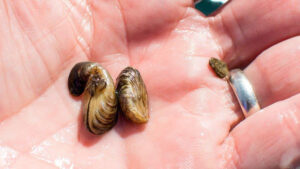
Quagga mussels
Cousins to zebra mussels, quagga mussels also colonize various structures and filter-feed. Quaggas arrived Lake Erie in 1989. See the following USGS links for more information: LINK 1 and LINK2.
PREVENT THE SPREAD
While our focus is fishing tactics, it’s important for anglers to take measures to help prevent the spread of zebra mussels and other invasive species. This includes cleaning, draining and drying your boat, trailer and equipment after fishing. For more information, watch this video created by Wired2Fish and Mercury Marine and visit 100thmeridian.org for other best practices.
Consider Balog and Robins’ tactics when chasing smallmouth in zebra-mussel lakes. Do so, and odds are good you’ll come home with a good ‘ole case of bass thumb courtesy of Mr. and Mrs. Small Jaws.
